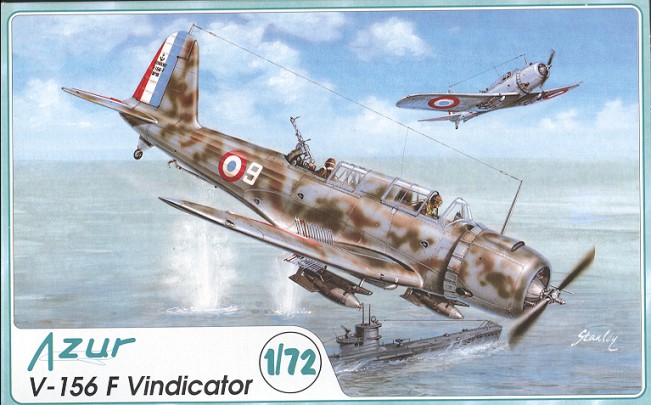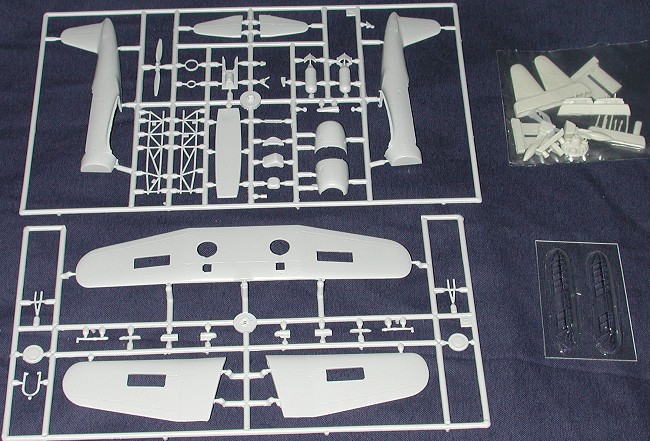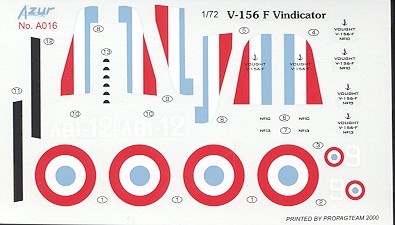
|
KIT: |
Azur 1/72 V-156F Vindicator |
|
KIT # |
016 |
|
PRICE: |
$15.98 |
|
DECALS: |
See review |
|
REVIEW & |
|
|
NOTES: |
Multimedia short run kit |

|
HISTORY |
Many of you will rightly say, 'Hey, this looks like an SB2U Vindicator. And you would be correct. In the late 1930s, it was pretty obvious that there was going to be some sort of conflict with the Germans. Many European nations were caught unprepared or chose to ignore all the warnings. Whatever the case may be, France was one of those countries. Knowing that its own factories would be unable to produce modern aircraft in the quantities needed, France turned to the one place that had a relatively large unused production capacity, the United States, for a number of things, including aircraft.
Amongst the aircraft sought were naval dive bombers and attack aircraft. There really wasn't much to choose from in the US that was truly modern, but France did purchase Curtiss SBC Helldiver biplanes and Vought SBU Vindicator monoplane naval bombers. The Vought aircraft were not exactly the same as was in use by the US Navy at the time. Several modifications were made to French requirements. One of them was the removal of the bomb crutch that swung the bomb clear of the propeller arc. French Vindicators would put their bombs under the wings so that wasn't needed.
Dive brakes were different on the French versions as well. The US used a perforated sheet type, while the French wanted the 'finger' type brakes as shown in the box art. Other changes were to French weapons and instruments. The French Vindicator also had the shorter tailplanes of the SB2U-1 and -2 versions.
Vindicators were delivered to France starting in 1939 and there were enough on hand to equip two bombing units, AB1 and AB2 by the time the war had started. These were used both against the Germans and the Italians, but attrition was quite high, only eight out of the forty received surviving. After the French surrender, aircraft still in the French order were sent to Britain, after being modified to British standards. These were called V-156Bs (Chesapeake by the British) and delivered in 1941. By then, the aircraft were obsolescent at best and the British found them to be totally unsuitable. They were used as trainers.
|
THE KIT |

As I mentioned in an earlier review, Azure kits are of aircraft used by the French. This particular kit is very typical of modern short run models. Light grey plastic, fine engraved detailing, good representations of fabric on the aft fuselage and wings, large sprue gates, ejector pin stubs on the large bits (wings, fuselage), a fret of etched metal, a bag of resin and two (!) clear and nicely formed vacuformed canopies. Options with the kit are dive brakes up or down and whether to install the DF loop antenna. A very nice touch is that the frame work inside the fuselage is given as a separate assembly, in fact, you build the interior into this framework. Fortunately, the kit is quite clean with very little flash and so cleanup should be a breeze.
The photo etched fret contains the fingers for the dive brakes and the square braces for the bomb fins. The resin, which is greenish grey and not the usual buff color, is for the dive brake wells, engine, underwing bomb racks and bombs, the shorter tailplanes, control sticks, rear machine gun, engine exhausts, carb intake and radio mast. One block of these resin bits are not listed in the parts breakdown at the beginning of the instructions, so take care when building.
 Instructions are quite good
showing 10 construction steps with the usual drawings of what goes where. Color
callouts are given in each step as appropriate using generic colors. None of the
colors are keyed to a particular paint manufacturer. You have a choice of two
aircraft, one camouflaged and one not. The camouflaged version is from 10
Escadrille, AB 3 at Hyres in Summer of 1940. The other is overall light blue
grey from 13 Escadrille, AB1 in early 1940. The decals are Propagteam, so you
know they are of a high quality. Both tail and elevator stripes are given, which
cuts down on the painting. For those who are adventurous, there are enough bits
in the basic kit to allow you to do an SB2U-3 Vindicator or any of the earlier,
more colorful USN planes. You only have to come up with the proper decals and do
a bit of modification to the dive brakes.
Instructions are quite good
showing 10 construction steps with the usual drawings of what goes where. Color
callouts are given in each step as appropriate using generic colors. None of the
colors are keyed to a particular paint manufacturer. You have a choice of two
aircraft, one camouflaged and one not. The camouflaged version is from 10
Escadrille, AB 3 at Hyres in Summer of 1940. The other is overall light blue
grey from 13 Escadrille, AB1 in early 1940. The decals are Propagteam, so you
know they are of a high quality. Both tail and elevator stripes are given, which
cuts down on the painting. For those who are adventurous, there are enough bits
in the basic kit to allow you to do an SB2U-3 Vindicator or any of the earlier,
more colorful USN planes. You only have to come up with the proper decals and do
a bit of modification to the dive brakes.
Overall, this looks like a great kit. It has everything you need to produce a fine 1/72 model of a very interesting aircraft. If you have had some experience with limited run kits, then you should give this one a try.
If you would like your product reviewed fairly and quickly by a site that has over 1,700 visits a day, please contact me or see other details in the Note to Contributors.